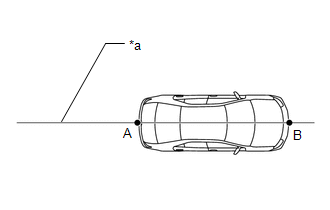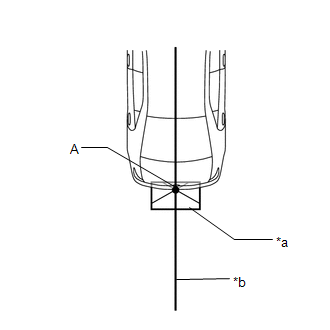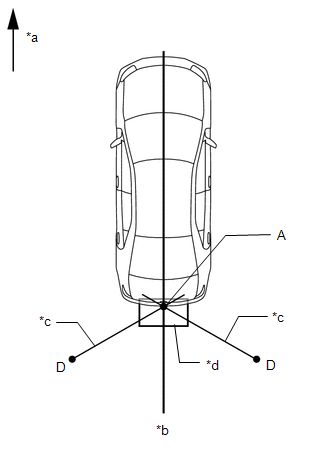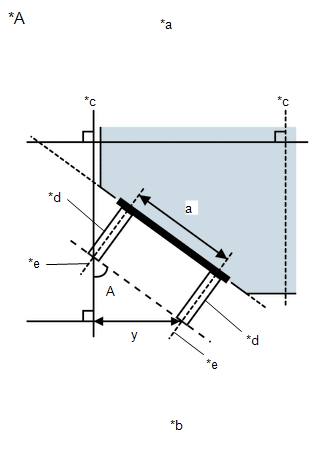Toyota Corolla Cross: Adjustment
ADJUSTMENT
PROCEDURE
1. BSM ECU DATE SAVE
NOTICE:
- Confirm that communication malfunction with other parts is not detected before changing blind spot monitor sensor.
- When the ECU data cannot be saved due to an ECU malfunction or a communication malfunction, perform the blind spot monitor beam axis confirmation.
- In the following situations, perform blind spot monitor beam axis confirmation
after the blind spot monitor sensor has been replaced with a new one.
- When a minor collision is suspected.
- For a vehicle that has undergone sheet metal repairs.
- For a vehicle in which the system frequently operates inappropriately or fails to operate.
- When a DTC for master module horizontal axis misalignment or slave module horizontal axis misalignment has been stored.
- When master module beam axis inspection is incomplete or slave module beam axis inspection is incomplete.
- When RoB code for master module dirty or slave module dirty has been stored.
- When RoB code for master module dirty Level 2 or slave module dirty Level 2 has been stored.
HINT:
By performing BSM "B" ECU data save or BSM "A" ECU data save, it becomes possible to save the beam axis adjustment value to the GTS.
(a) Turn the ignition switch off.
(b) Connect the GTS to the DLC3.
(c) Turn the ignition switch to ON.
(d) Enter the following menus: Body Electrical / Blind Spot Monitor "B" or Blind Spot Monitor "A" / Utility.
HINT:
The "B" is on the LH side and the "A" is on the RH side.
|
Part Name |
Tester Item |
|---|---|
|
Blind spot monitor sensor LH |
Blind Spot Monitor "B" |
|
Blind spot monitor sensor RH |
Blind Spot Monitor "A" |
|
Tester Display |
|---|
|
BSM "B" ECU Data Save |
|
Tester Display |
|---|
|
BSM "A" ECU Data Save |
(e) Check the results displayed for the BSM "B" ECU data save or BSM "A" ECU data save.
2. BSM ECU DATE WRITE
NOTICE:
- The value saved from the old blind spot monitor sensor RH before replacement should be written to the new blind spot monitor sensor RH.
- The value saved from the old blind spot monitor sensor LH before replacement should be written to the new blind spot monitor sensor LH.
- In the following situations, to prevent incorrect or unnecessary operation
of the blind spot monitor sensor, do not perform the procedure to write
data to the BSM ECU.
- When the BSM data was copied from a different vehicle than the one to which BSM data will be written.
- When the BSM ECU data saved from the old blind spot monitor sensor LH before replacement will be written to a new blind spot monitor sensor RH.
- When the BSM ECU data saved from the old blind spot monitor sensor RH before replacement will be written to a new blind spot monitor sensor LH.
HINT:
By performing BSM "B" ECU data write or BSM "A" ECU data write, the beam axis adjustment value from the old blind spot monitor sensor before replacement can be written to the new blind spot monitor sensor.
(a) Turn the ignition switch off.
(b) Connect the GTS to the DLC3.
(c) Turn the ignition switch to ON.
(d) Enter the following menus: Body Electrical / Blind Spot Monitor "B" or Blind Spot Monitor "A" / Utility.
HINT:
The "B" is on the LH side and the "A" is on the RH side.
|
Part Name |
Tester Item |
|---|---|
|
Blind spot monitor sensor LH |
Blind Spot Monitor "B" |
|
Blind spot monitor sensor RH |
Blind Spot Monitor "A" |
|
Tester Display |
|---|
|
BSM "B" ECU Data Write |
|
Tester Display |
|---|
|
BSM "A" ECU Data Write |
(e) Check the results displayed for the BSM "B" ECU data write or BSM "A" ECU data write.
3. PERFORM BLIND SPOT MONITOR BEAM AXIS CONFIRMATION
HINT:
The blind spot monitor beam axis confirmation is performed to confirm whether the sensor's beam axis is correct, and perform adjustment of the beam axis by using reflector.
(a) When performing the blind spot monitor beam axis confirmation, move the vehicle to a place where the space shown in the illustration can be secured.
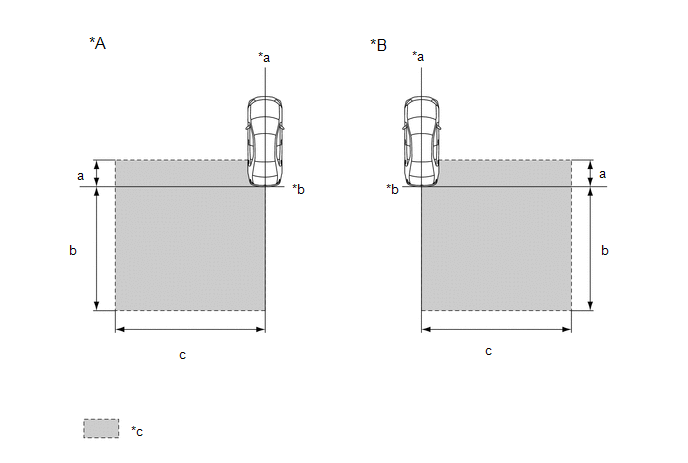
|
*A |
Left Side of Vehicle |
*B |
Right Side of Vehicle |
|
*a |
Vehicle Center Line |
*b |
Rear Bumper |
|
*c |
Inspection Area |
- |
- |
Standard:
|
Location |
Measurement |
|---|---|
|
a |
1 m (3.28 ft.) |
|
b |
5 m (16.41 ft.) |
|
c |
6 m (19.68 ft.) |
NOTICE:
- Perform this inspection on level ground.
- Make sure that there are no metal objects around the vehicle or on the ground.
- Unload the vehicle before beginning the inspection.
- Confirm that the tire pressure is correct before beginning the inspection.
- Do not place any objects other than the reflector (such as a large metallic object) in or allow people to enter the inspection area (W 6 m [19.68 ft.] x L 6 m [19.68 ft.] x H 4 m [13.12 ft.]) shown in the illustration.
(b) Place the reflector.
(1) Hang a weight with a pointed tip from the center of the rear emblem, and mark the rear center point of the vehicle (point A) on the ground.
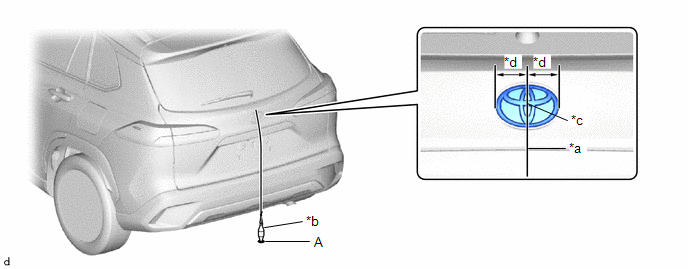
|
*a |
String |
*b |
Weight |
|
*c |
Center Point |
*d |
Bilateral Symmetry |
HINT:
Lightly flick the string with your fingers several times to confirm that the string is aligned with mark A.
(2) Hang a weight with a pointed tip from the center of the radiator grille (or front panel) emblem, and mark the front center point of the vehicle (point B) on the ground.
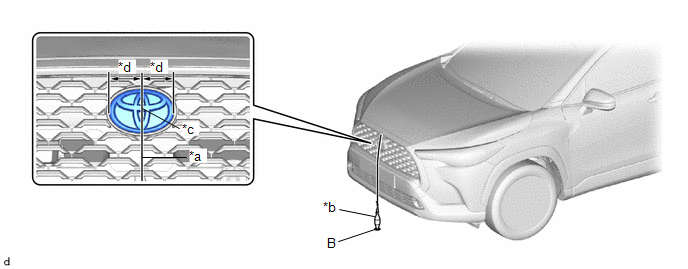
|
*a |
String |
*b |
Weight |
|
*c |
Center Point |
*d |
Bilateral Symmetry |
HINT:
Lightly flick the string with your fingers several times to confirm that the string is aligned with mark B.
|
(3) Draw a vehicle center line so that it passes through mark A and B (front and rear center points). |
|
(4) Enlarge and print out the poster shown in the illustration.
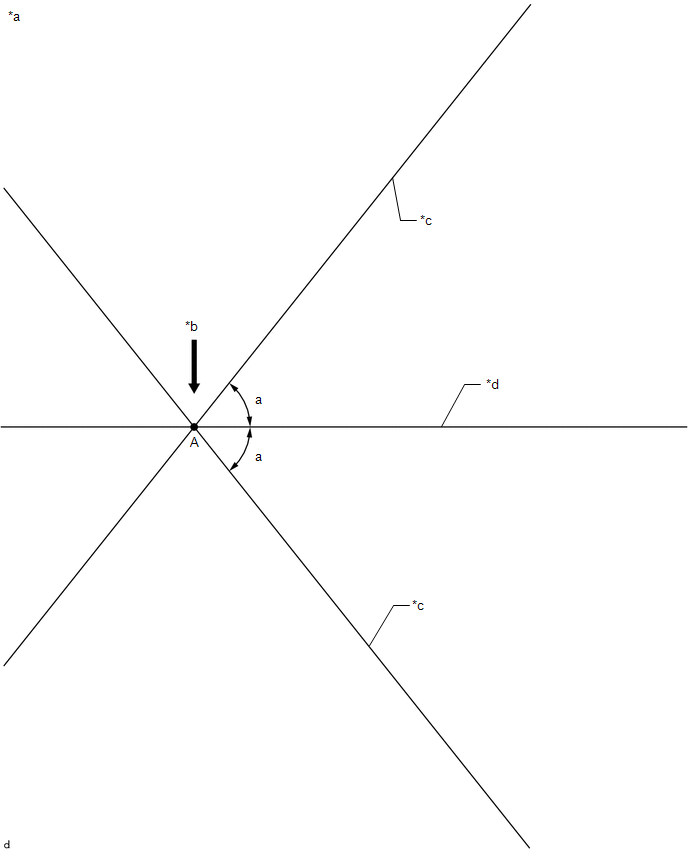
|
*a |
Poster |
*b |
Edge of Rear Bumper |
|
*c |
Line C |
*d |
Vehicle Center Line |
Standard:
|
Part |
Angle |
|---|---|
|
a |
51.4° |
|
(5) Attach the printed poster to the floor with the vehicle center line aligned with point A as shown in the illustration. |
|
|
(6) Align a piece of string with line C and mark point D at a distance of 3377 mm (11.08 ft.) from point A. |
|
(7) Set the reflector at the point D shown in the illustration below.
SST: 09870-60000
09870-60010
SST: 09870-60040
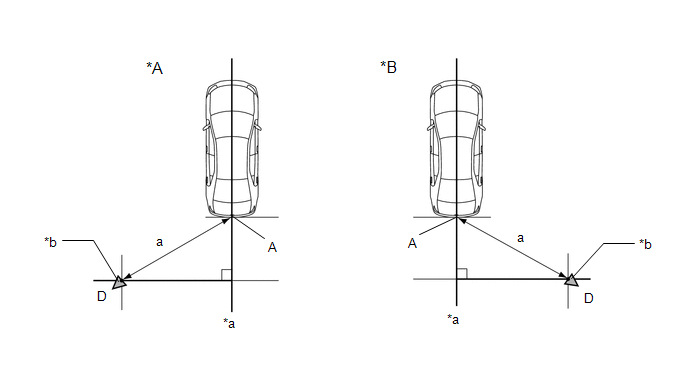
|
*A |
Left Side of Vehicle |
*B |
Right Side of Vehicle |
|
*a |
Vehicle Center Line |
*b |
Reflector |
Standard:
|
Part |
Length |
|---|---|
|
a |
3377 mm (11.08 ft.) |
NOTICE:
- Set the reflector so that its center is 896 mm (2.94 ft.) above the
ground.
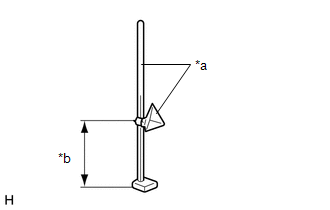
*a
SST (reflector)
*b
896 mm (2.94 ft.)
- The center of the triangular pyramid is the reference point for the
setting position and angle.
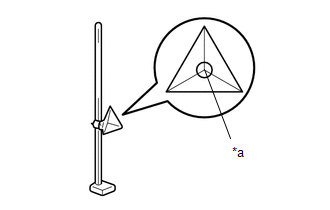
*a
Center of Triangular Pyramid
(c) Perform the blind spot monitor beam axis display.
(1) Turn the ignition switch off.
(2) Connect the GTS to the DLC3.
(3) Turn the ignition switch ON.
(4) Turn the blind spot monitor system on.
(5) Turn the GTS on.
(6) Enter the following menus: Body Electrical / Blind Spot Monitor "B" or Blind Spot Monitor "A" / Utility / BSM "B" Beam Axis Display or BSM "A" Beam Axis Display.
HINT:
The "B" is on the LH side and the "A" is on the RH side.
|
Part Name |
Tester Item |
|---|---|
|
Blind spot monitor sensor LH |
Blind Spot Monitor "B" |
|
Blind spot monitor sensor RH |
Blind Spot Monitor "A" |
|
Tester Display |
|---|
|
BSM "B" Beam Axis Display |
|
Tester Display |
|---|
|
BSM "A" Beam Axis Display |
(7) Check the results displayed for the BSM beam axis display.
Allowable Range:
|
Item |
Blind Spot Monitor Sensor LH (Master) |
Blind Spot Monitor Sensor RH (Slave) |
|---|---|---|
|
Angle |
-3.6 to +3.6° |
-3.6 to + 3.6° |
HINT:
If the displayed results are outside the permissible range, the following are possible causes. Therefore, implement countermeasures, check the blind spot monitor beam axis and perform the procedure again.
|
Possible Causes |
Countermeasure |
|---|---|
|
Incorrect SST (reflector) position |
Check the position of SST (reflector) and checking space and perform the procedure again |
|
A metallic object is located in the vicinity of the checking space |
Check the position of SST (reflector) and checking space and perform the procedure again |
|
The blind spot monitor sensor installation is abnormal |
Check the installation condition of the blind spot monitor sensor |
(d) Perform the blind spot monitor beam axis adjustment.
(1) Enter the following menus: Body Electrical / Blind Spot Monitor "B" or Blind Spot Monitor "A" / Utility / BSM "B" Beam Axis Adjustment or BSM "A" Beam Axis Adjustment.
Body Electrical > Blind Spot Monitor "B" > Utility|
Tester Display |
|---|
|
BSM "B" Beam Axis Adjustment |
|
Tester Display |
|---|
|
BSM "A" Beam Axis Adjustment |
HINT:
When values on the axis display are in the allowable range, performing this adjustment compensates for any deviation from the normal value.
4. PERFORM BLIND SPOT MONITOR SENSOR INSTALLATION CONDITION INSPECTION
NOTICE:
- Perform this inspection on level ground.
- Unload the vehicle before beginning the inspection.
- Confirm that the tire pressure is correct before beginning the inspection.
HINT:
- The blind spot monitor sensor installation condition inspection is performed to confirm whether the sensor is perpendicular to the floor surface (+/-2.2°) by using a digital angle gauge, and that the sensor is 46 to 54° from the line parallel to the vehicle center line.
- Use the same procedure for the RH side and LH side.
- The following procedure is for the LH side.
(a) Remove the rear bumper assembly.
(b) Place the digital angle gauge on a level (gradient within 1%) and perform zero-point adjustment as shown in the illustration.
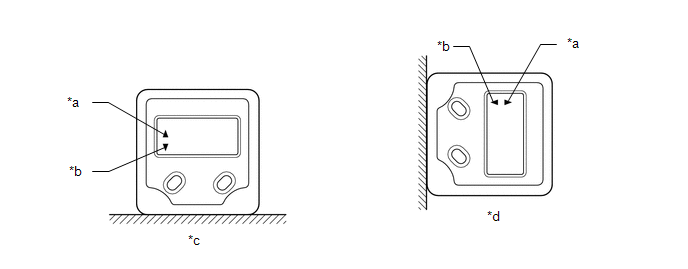
|
*a |
(+) |
*b |
(-) |
|
*c |
When Storing Zero Point |
*d |
After Storing Zero Point, Indicates 90° When Fully Horizontal |
(c) Set the digital angle gauge to the outward facing surface of the blind spot monitor sensor as shown in the illustration, and check that the perpendicular angle of the blind spot monitor sensor is within the permissible range.

|
*a |
Digital Angle Gauge |
|
*b |
Blind Spot Monitor Sensor |
|
*c |
Outward Facing Surface |
HINT:
The outward facing surface (installation angle) is positive (+) when it faces higher than horizontal.
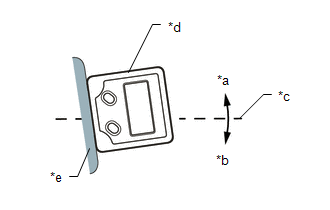
|
*a |
(+) |
|
*b |
(-) |
|
*c |
Horizontal Line |
|
*d |
Digital Angle Gauge |
|
*e |
Outward Facing Surface |
Standard:
|
Item |
Allowable Range |
|---|---|
|
Blind Spot Monitor Sensor LH (Master) |
+87.8 to +92.2° |
|
Blind Spot Monitor Sensor RH (Slave) |
+87.8 to +92.2° |
|
(d) Using the sensor installation stud bolt center lines as a reference, check that the stud bolts are as shown in the illustration. Standard:
HINT: If the results are not as specified, it is possible that the blind spot monitor sensor installation area (frame, stud bolt) is deformed, so make corrections as necessary. |
|

